library(bbr)
library(dplyr)
library(pmplots)
library(here)
library(yspec)
library(glue)
library(patchwork)
library(mrgmisc)
library(yaml)
library(knitr)
library(pmtables)1 Introduction
During model development goodness-of-fit (GOF) diagnostic plots are generated to assess model fit. Here we demonstrate how to generate diagnostic plots for models using the pmplots and yspec packages. For more information on which diagnostics are most appropriate for your project and how to interpret them please refer to the Other resources section at the bottom of this page.
After working through how to create the diagnostic plots on this page we recommend looking at the Parameterized Reports for Model Diagnostics page. There we show how you can put this code into an R Markdown template and use a feature of R Markdown, the “parameterized report”, to generate a series of diagnostic plots. The idea is that you might create one or two templates during the course of your project and then render each template from the single model-diagnostics.R script to generate diagnostic plots for multiple models.
2 Tools used
2.1 MetrumRG packages
yspec Data specification, wrangling, and documentation for pharmacometrics.
pmplots Create exploratory and diagnostic plots for pharmacometrics.
bbr Manage, track, and report modeling activities, through simple R objects, with a user-friendly interface between R and NONMEM®.
2.2 CRAN packages
dplyr A grammar of data manipulation.
mrgmisc Format, manipulate and summarize data in the field of pharmacometrics.
3 Outline
Our model diagnostics are made using the pmplots package and leveraging the information provided in the spec file through the yspec package functions.
Below we demonstrate how to read in your NONMEM® output and create the following plots:
- Observed vs predicted diagnostic plots
- Normalized prediction distribution error (NPDE) diagnostic plots
- Conditional weighted residuals (CWRES) diagnostic plots
- Empirical Bayes estimate(EBE)-based diagnostic plots
This is obviously not an exhaustive list and, while we make diagnostics for the final model, run 106, this code can be used for all models. The pk.csv data set used in these examples is in data/derived/ and has an accompanying spec file, pk.yml.
Before continuing, it’s important you’re familiar with the following terms to understand the examples below:
- yspec: refers to the package.
- spec file: refers to the data specification yaml describing your data set.
- spec object: refers to the R object created from your spec file and used in your R code.
More information on these terms is given on the Introduction to yspec page.
4 Set up
4.1 Required packages
5 Extracting information from your spec file
5.1 Load your spec file
spec <- ys_load(here("data","derived","pk.yml"))
head(spec) name info unit short source
1 C cd- . Commented rows lookup
2 NUM --- . Row number lookup
3 ID --- . NONMEM ID number lookup
4 TIME --- hour Time after first dose lookup
5 SEQ -d- . Data type lookup
6 CMT -d- . Compartment lookup
7 EVID -d- . Event identifier lookup
8 AMT --- mg Dose amount lookup
9 DV --- ng/mL Concentration lookup
10 AGE --- years Age lookup5.2 Namespace options
Useys_namespace to view the available namespaces - here we’re going to use the plot namespace.
ys_namespace(spec)namespaces: - base
- long
- plot
- texspec <- ys_namespace(spec, "plot")5.3 Extract data from your spec object
The covariates of interest for your diagnostic plots could be defined explicitly in the code, for example,
diagContCov <- c("AGE","WT","ALB","EGFR")
diagCatCov <- c("STUDY", "RF", "CP", "DOSE")Alternatively, you can define the covariates of interest once in your spec file using flags and simply read them in here
diagContCov <- pull_meta(spec, "flags")$diagContCov
diagCatCov <- pull_meta(spec, "flags")$diagCatCov6 Read in the model output
6.1 Model Object
We use read_model from the bbr package to read the model details into R and assign it to a mod object.
This mod object can be piped to other functions in the bbr package to further understand the model output, for example, by passing the mod object to the model_summary function you can see
- the analysis dataset location
- the number of records, observations and subjects included
- the objective function and estimation method(s)
- a summary of any heuristic problems detected
- a table of the model parameter estimates, standard errors and shrinkage
mod <- read_model(here("model","pk","106"))
sum <- mod %>% model_summary()6.2 Model dataset
All our NONMEM®-ready datasets include a row number column (a unique row identifier typically called NUM) that’s added during data assembly. And, when running NONMEM® models, we always request this NUM column in each $TABLE. This allows us to take advantage of a bbr function called nm_join that reads in all output table files and joins them back to the input data set.
data0 <- nm_join(mod)The idea is that in NONMEM®, you table just NUM and no other input data items because these all get joined back to the nonmem output (including the character columns) by nm_join.
By default, the input data is joined to the table files so that the number of rows in the result will match the number of rows in the table files (i.e., the number of rows not bypassed via $IGNORE statements). Use the .superset argument to join table outputs to the (complete) input data set.
The plot data should include the observation records only (i.e., EVID==0) and we use the decode information in your spec object, with the yspec_add_factors function, to convert the numerical columns to factors with levels and labels that match the decode descriptions for the plot labels.
data <-
data0 %>%
filter(EVID==0) %>%
yspec_add_factors(spec, .suffix = "")7 General diagnostic plots
7.1 Observed vs predicted plots
Observed (DV) vs predicted (PRED or IPRED) plots can be created easily using the dv_pred and dv_ipred functions in pmplots. These functions include several options to customize your plots, including using more specific names (shown below).
dvp <- dv_pred(data, yname = "concentration (mg/L)")
dvp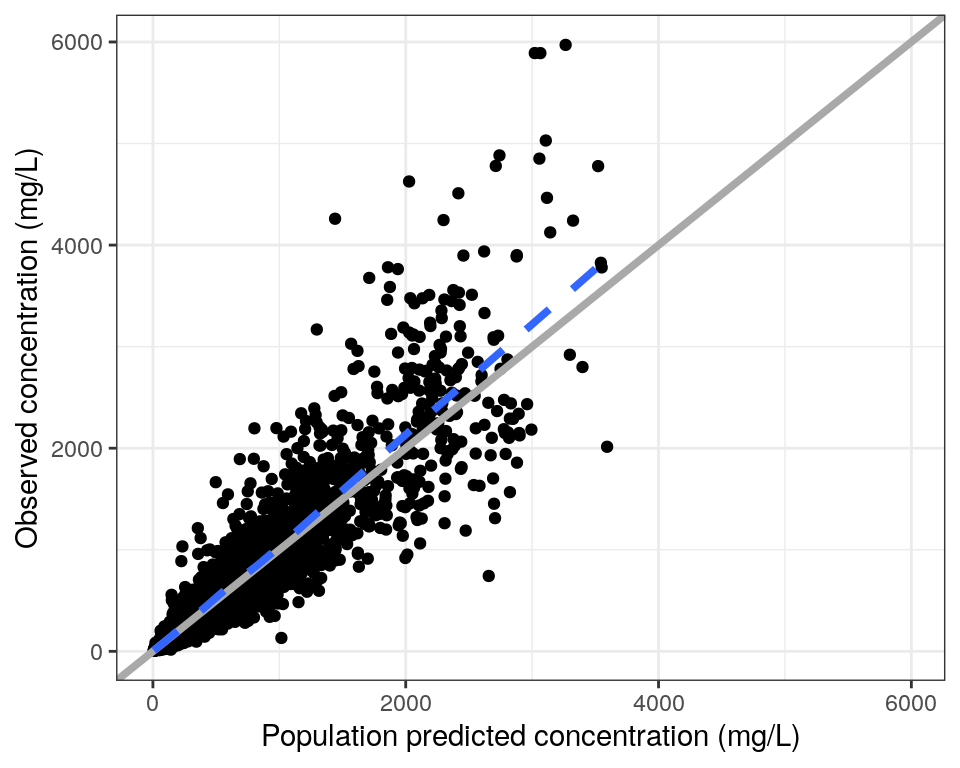
dvip <- dv_ipred(data, yname = "concentration (mg/L)")
dvip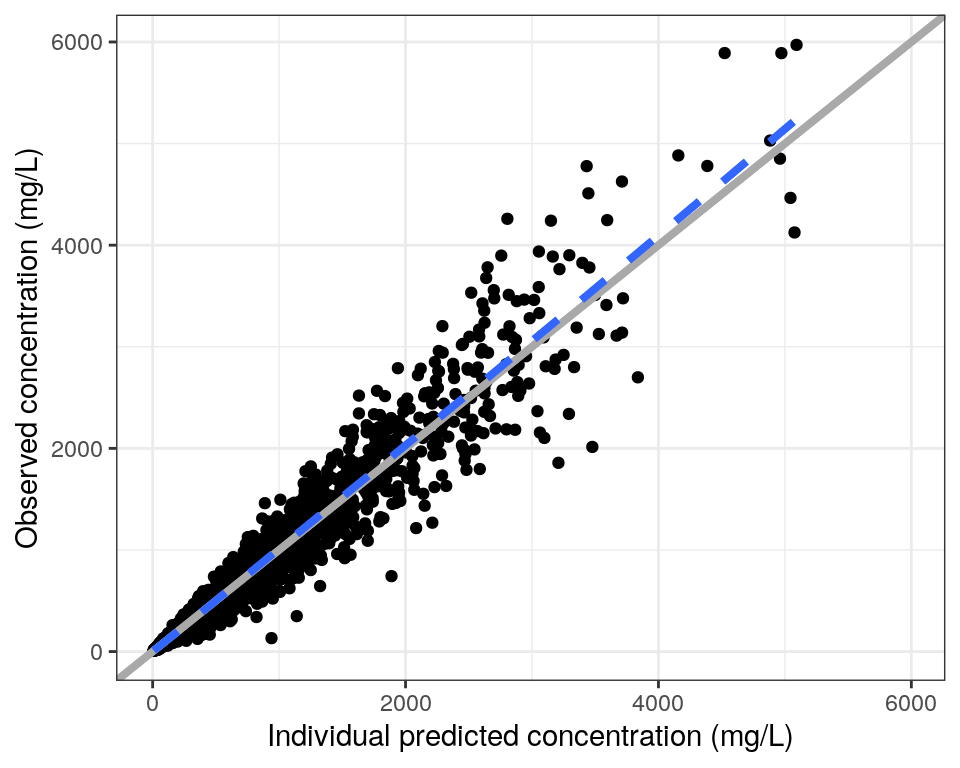
7.2 Individual observed vs predicted plots
Individual plots of DV, PRED and IPRED vs time (linear and log scale) are generated with the dv_pred_ipred function. These plots are highly customizable but here we show the first plot from a simple example
dvip <- dv_pred_ipred(
data,
id_per_plot = 9,
ncol = 3,
angle = 45,
use_theme = theme_bw()
)
dvip[1]$`1`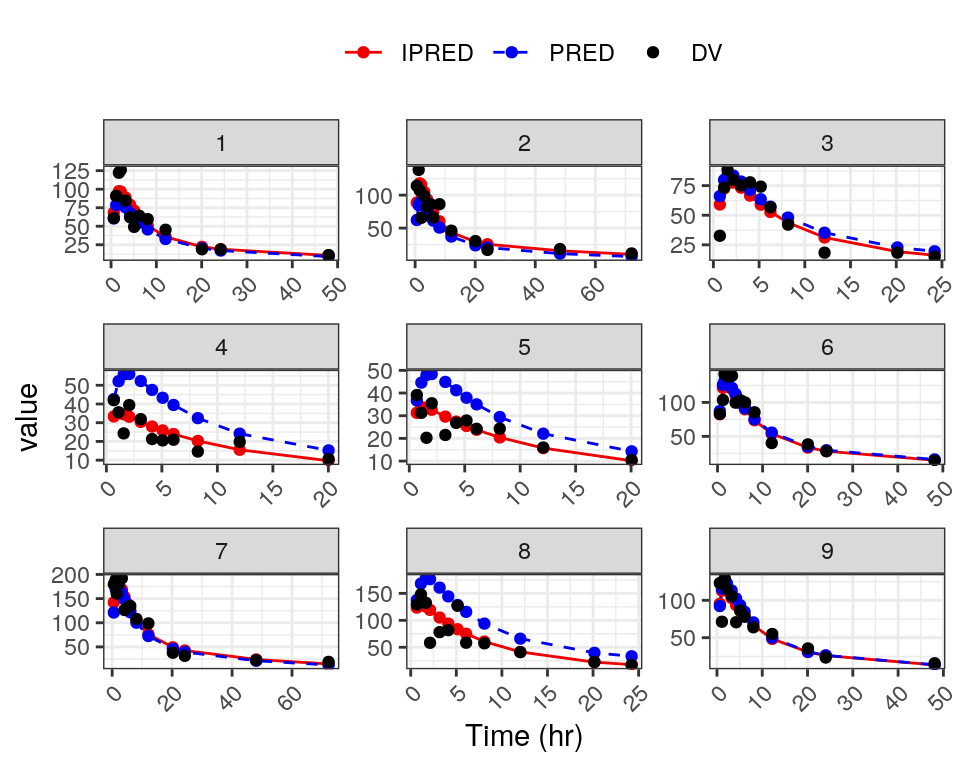
7.3 NPDE Plots
The pmplots package includes a series of functions for plotting normalized prediction distribution errors (NPDEs):
npde_predNPDE vs the population predictions (PRED)npde_timeNPDE vs timenpde_tadNPDE vs time after dose (TAD)npde_contNPDE vs continuous covariatesnpde_catNPDE vs categorical ocvariatesnpde_histdistribution of NPDEs
Again, these functions can be customized and below we show how you can customize the axis labels using information in your spec file, how to map across multiple covariates and how to panel multiple plots into a single figure with the patchwork package.
7.3.1 NPDE vs population predictions, time and time after dose
The pmplots package provides basic, intuitive axes labels automatically for plots created using it’s functions. However, it also include a series of functions that you can use to customize those labels. Here we demonstrate how to grab the units for time from your spec object and append them to the time labels, and how to include your models specific endpoint with units (in this case, concentration (mg/L)).
xTIME <- pm_axis_time(spec$TIME$unit)
xTIME[1] "TIME//Time (h)"xTAD <- pm_axis_tad(spec$TAD$unit)
xPRED <- glue(pm_axis_pred(), xname = "concentration (mg/L)")p1 <- npde_pred(data, x = xPRED, y = "NPDE // ")
p2 <- npde_time(data, x = xTIME)
p3 <- npde_tad(data, x = xTAD, y = "NPDE // ")
p <- p1 / p2 / p3
p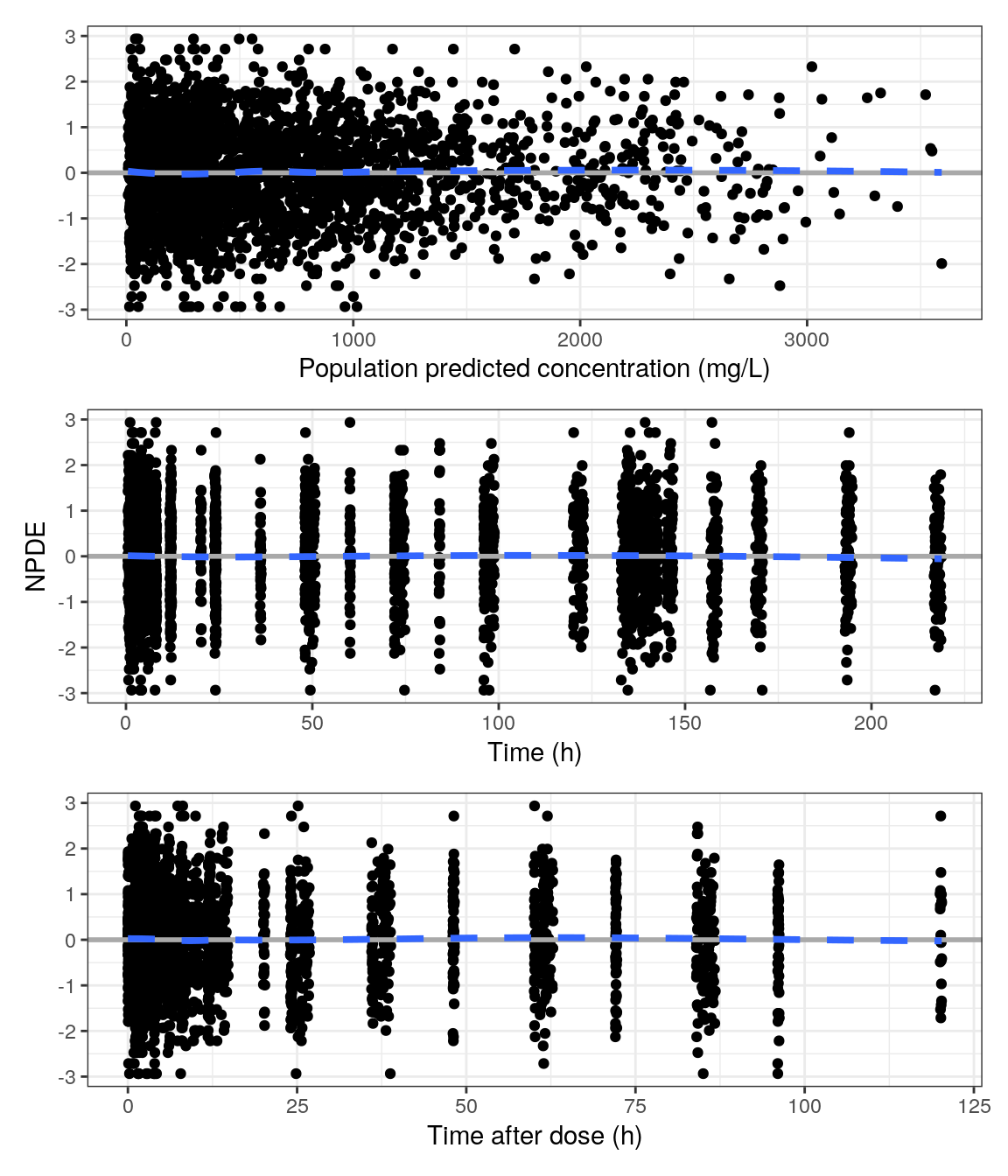
7.3.2 NPDE vs continuous covariates
The NPDE vs continuous covariate plots leverage the information in your spec object in two main ways:
- the covariates of interest are extracted from the covariate flags in your spec file using the
pull_metafunction from yspec (also described above). - the axis labels are renamed with the short label in the spec
diagContCov <- pull_meta(spec, "flags")$diagContCov
NPDEco <-
spec %>%
ys_select(all_of(diagContCov)) %>%
axis_col_labs(title_case = TRUE, short_max = 10) %>%
as.list()
NPDEco$AGE
[1] "AGE//Age (years)"
$WT
[1] "WT//Weight (kg)"
$ALB
[1] "ALB//Albumin (g/dL)"
$EGFR
[1] "EGFR//eGFR (mL/min/1.73m2)"pList <- purrr::map(NPDEco, ~ npde_cont(data, x = .x))
pm_grid(pList, ncol = 2)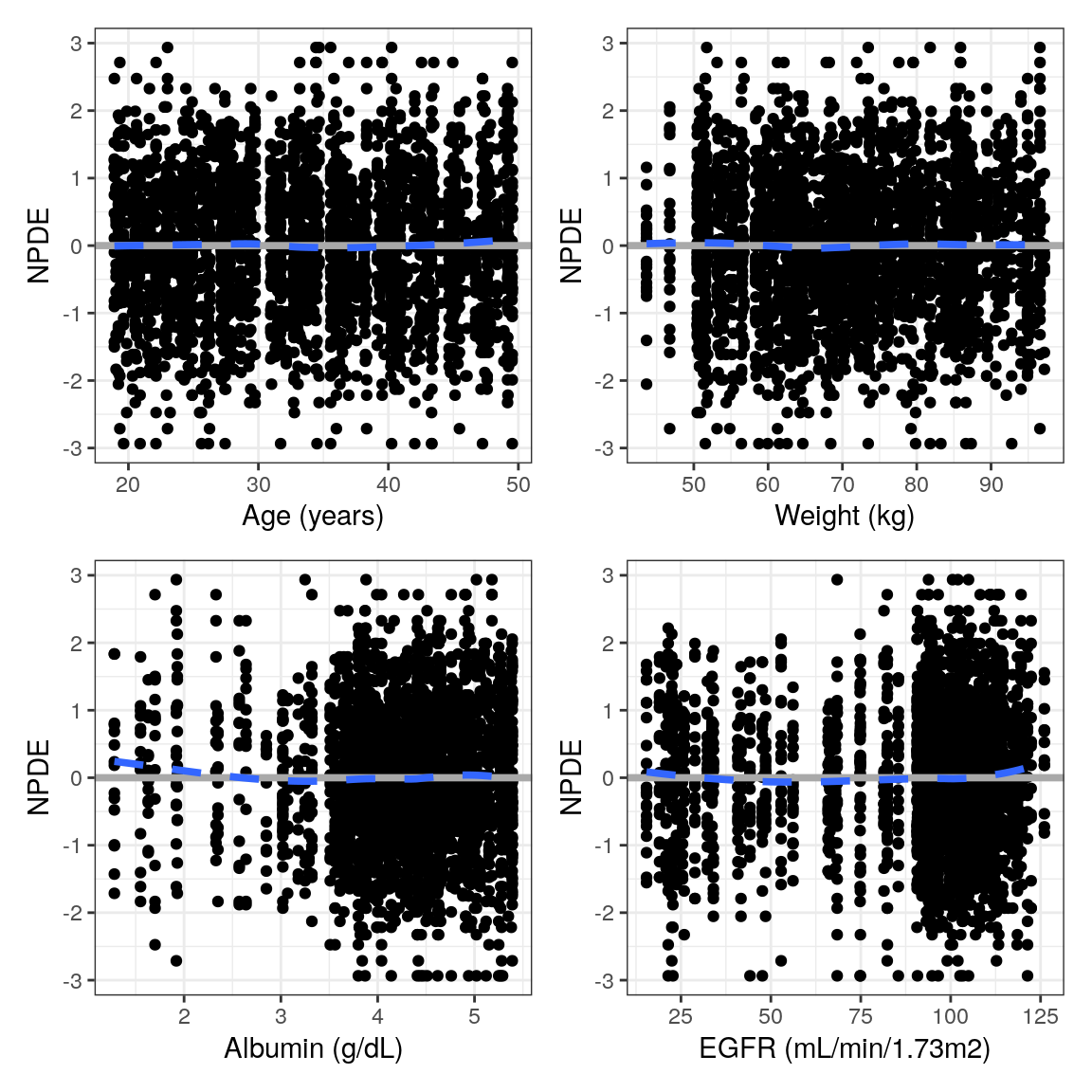
7.3.3 NPDE vs categorical covariates
As above, the information in the spec object was used to to rename the axis labels. These plots also used the spec object to decode the numerical categorical covariate categories (shown above).
NPDEca <-
spec %>%
ys_select("RF", "CP") %>%
axis_col_labs(title_case = TRUE, short_max = 20) %>%
as.list()
pList_cat = purrr::map(NPDEca, ~ npde_cat(data, x = .x))
pm_grid(pList_cat, ncol=1)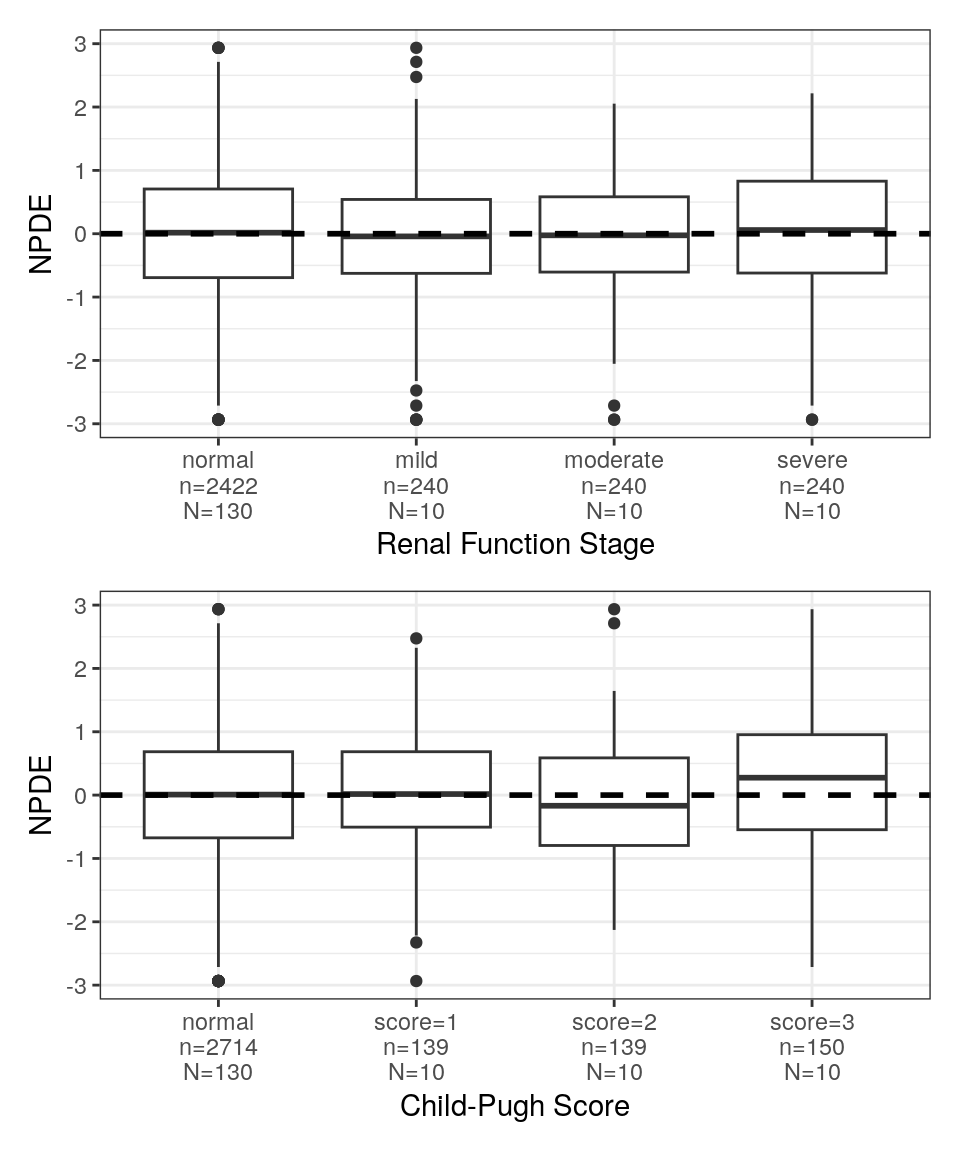
7.3.4 NPDE histogram
Here we show an NPDE density plot but the y-axis can be customized to show count or density.
p <- npde_hist(data)
p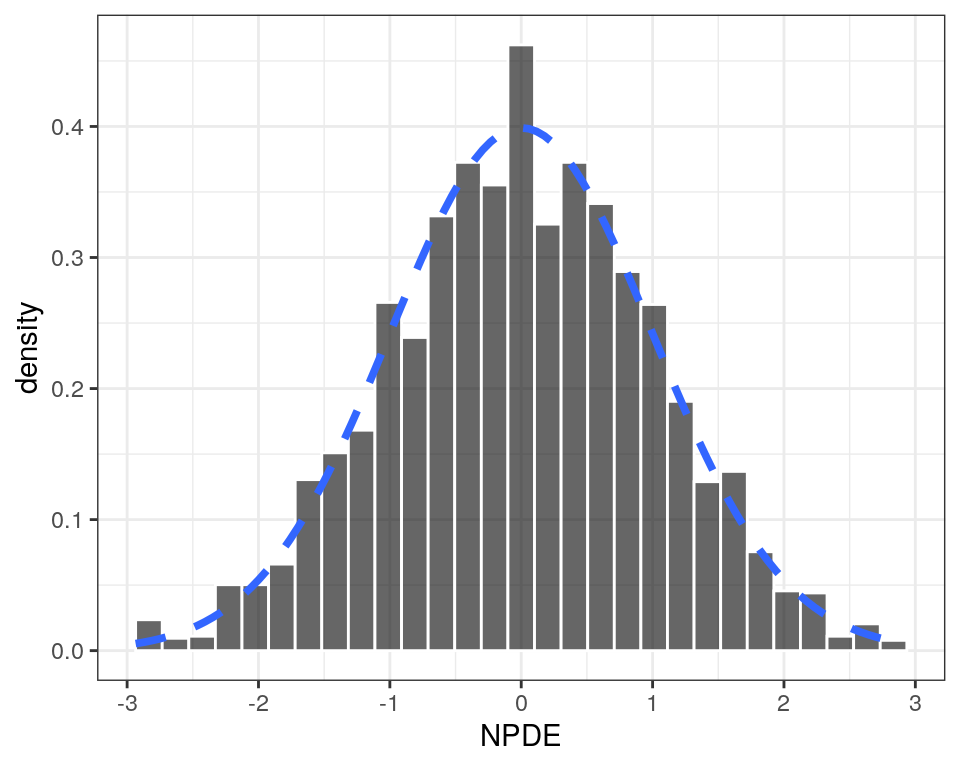
7.4 Other residual plots
The pmplots package includes a similar series of functions to create other residual plots. They’re all similarly named but instead of beginning with npde_ they’re prefaced with
res_for residual functions/plotswres_for weighted residual functions/plotscwres_for conditional weighted residual functions/plotscwresi_for conditional weighted residual with interaction functions/plots
Below are a couple of examples of CWRES plots.
7.4.1 CWRES vs population predictions, time and time after dose
p1 <- cwres_pred(data, x = xPRED, y = "CWRES // ")
p2 <- cwres_time(data, x = xTIME)
p3 <- cwres_tad(data, x = xTAD, y = "CWRES // ")
p <- p1 / p2 / p3
p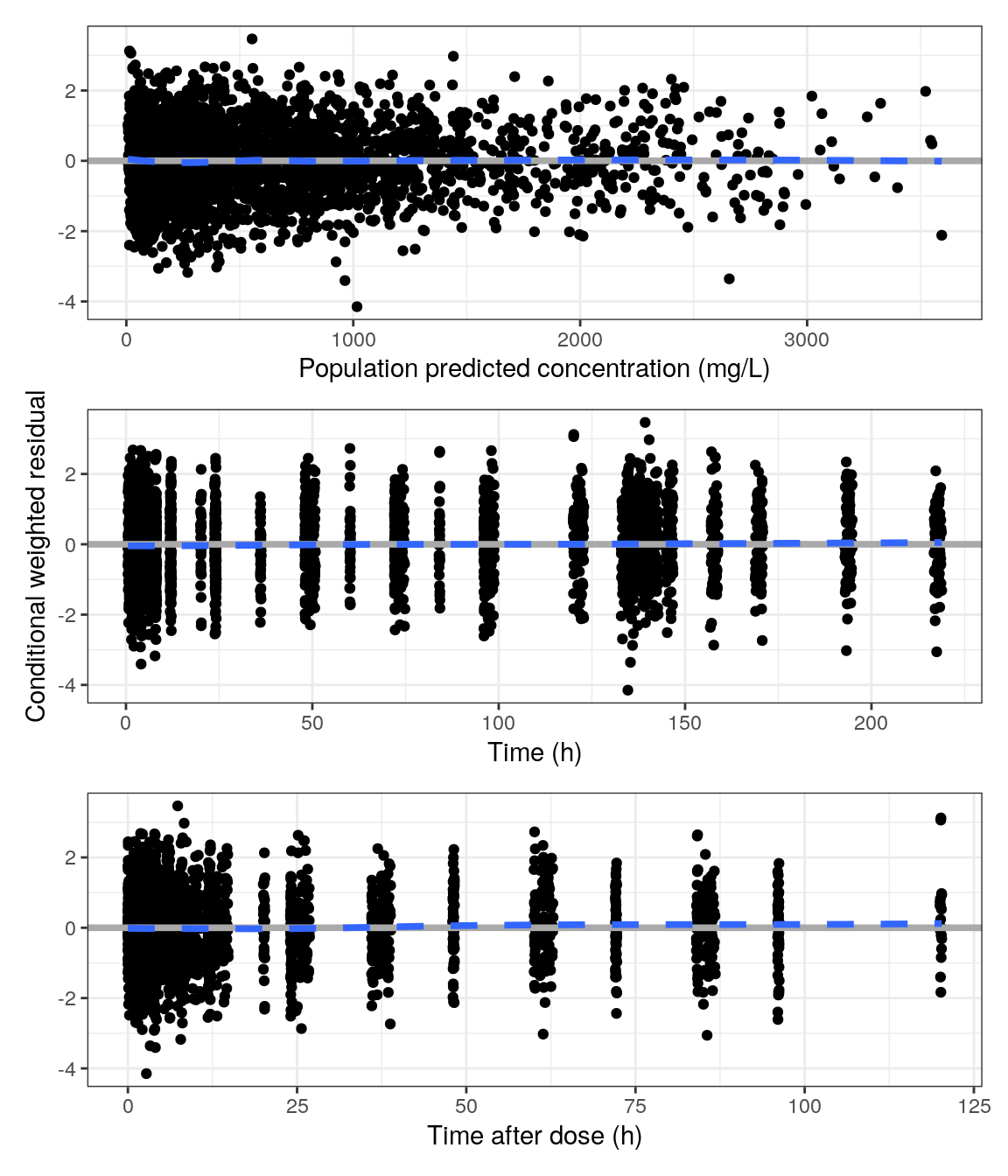
7.4.2 CWRES quantile-quantile (QQ) and density histogram
p <- cwres_q(data) / cwres_hist(data)
p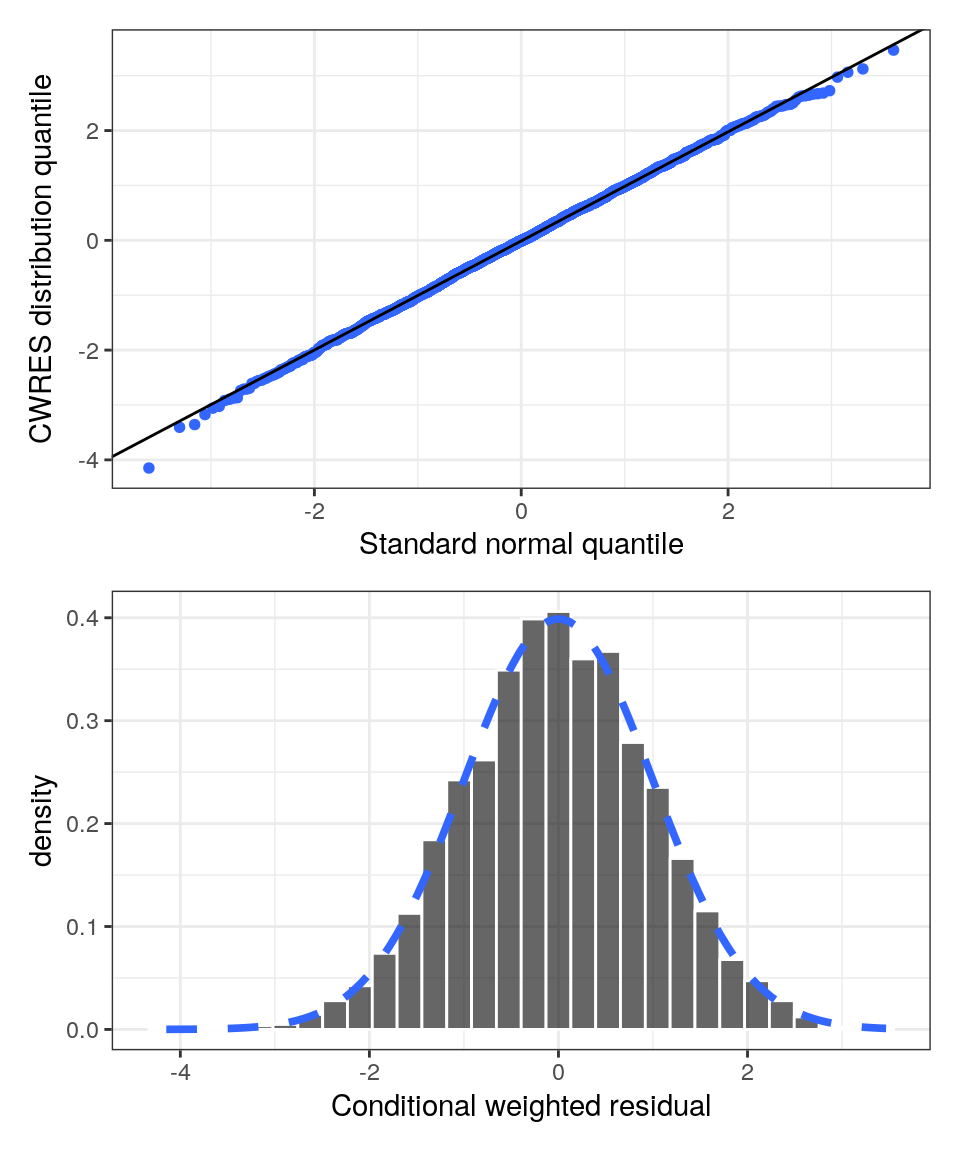
8 EBE-based diagnostics
The ETA based plots require a dataset filtered to one record per subject
id <- distinct(data, ID, .keep_all=TRUE) Here we show how to plot:
eta_pairsthe correlation and distribution of model ETAseta_contETA vs continous covariateseta_catETA vs categorical covariates
Again we’ll leverage the information in the spec object in several ways:
- the covariates of interest are extracted from the covariate flags in your spec file using the
pull_metafunction and those covariates are selected from the spec object usingys_selectfunction (also described above). - the axis labels are renamed with the short label in the spec using
axis_col_labs - numerical categorical covariates are decoded with the
yspec_add_factorsfunction
The ETAs to be plotted can either be extracted programatically
etas <- stringr::str_subset(names(data), "ETA")or you can create a list with labels that replace the ETA numbers in your plots
etas <- c("ETA1//ETA-KA", "ETA2//ETA-V/F", "ETA3//ETA-CL/F")8.1 ETA pairs plot
p <- eta_pairs(id, etas)
p
8.2 ETA vs continuous covariates
Here we use a map_wrap_eta_cont function to generate plots of all continuous covariates vs each ETA value in a single line. Note that in this case we map over the ETAs and produce one plot per ETA faceted by continous covariates. Below we show a similar example for categorical covariates but there we’ll create one plot per covariate and ETA pair. For brevity we’ll show an example of the first plot but the code produces one plot per ETA.
co <-
spec %>%
ys_select(all_of(diagContCov)) %>%
axis_col_labs(title_case = TRUE, short_max = 10)
p <- purrr::map(.x = etas, ~ map_wrap_eta_cont(.x, co, id))
p[[1]]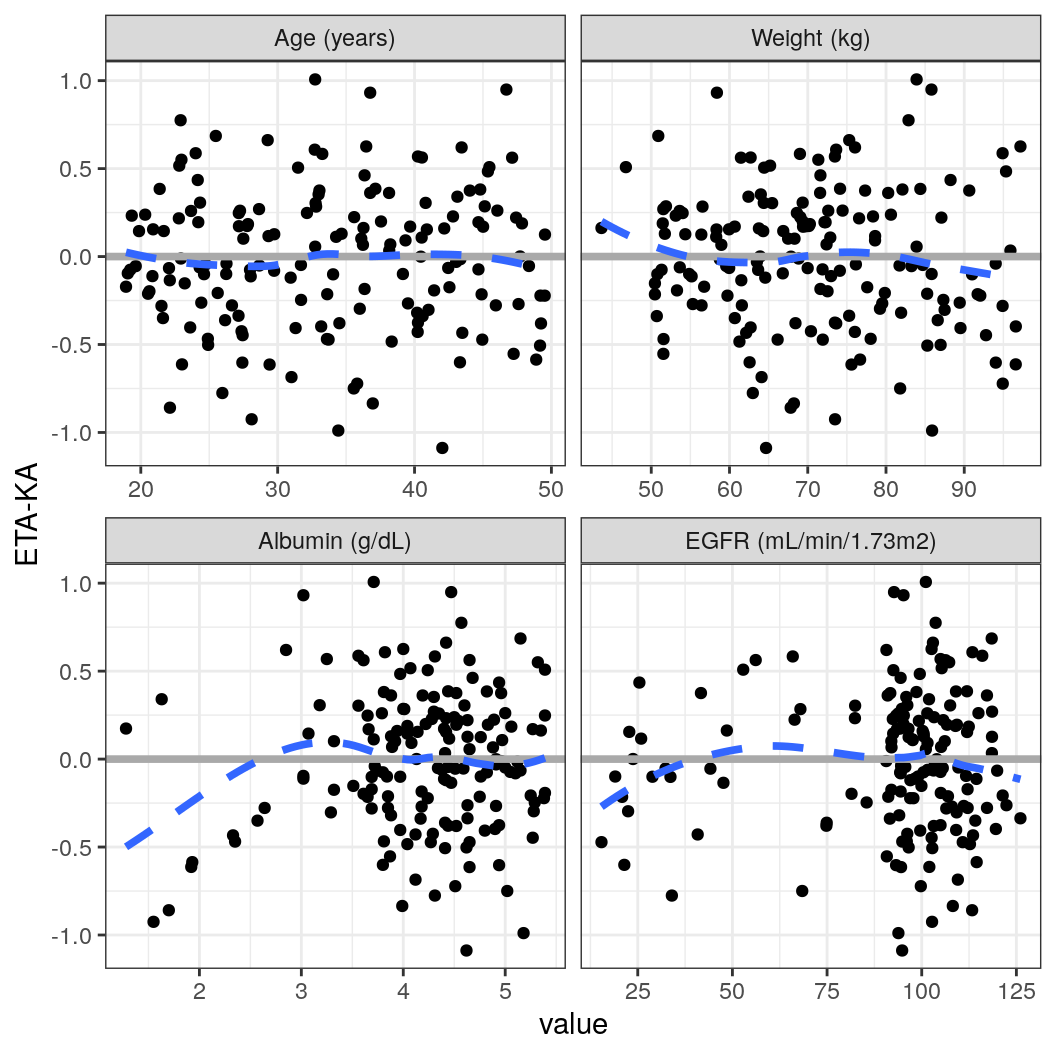
8.3 ETA vs categorical covariate
Here we show how to map over the categorical covariates of interest and to create one plot per covariate and ETA pair. These plots can be combined using the patchwork package.
ca <-
spec %>%
ys_select(all_of(diagCatCov)) %>%
axis_col_labs(title_case=TRUE, short_max = 20)
p <- eta_cat(id, ca, etas)
pRenal <- (p[[5]] + p[[6]]) / (p[[7]] + p[[8]])
pRenal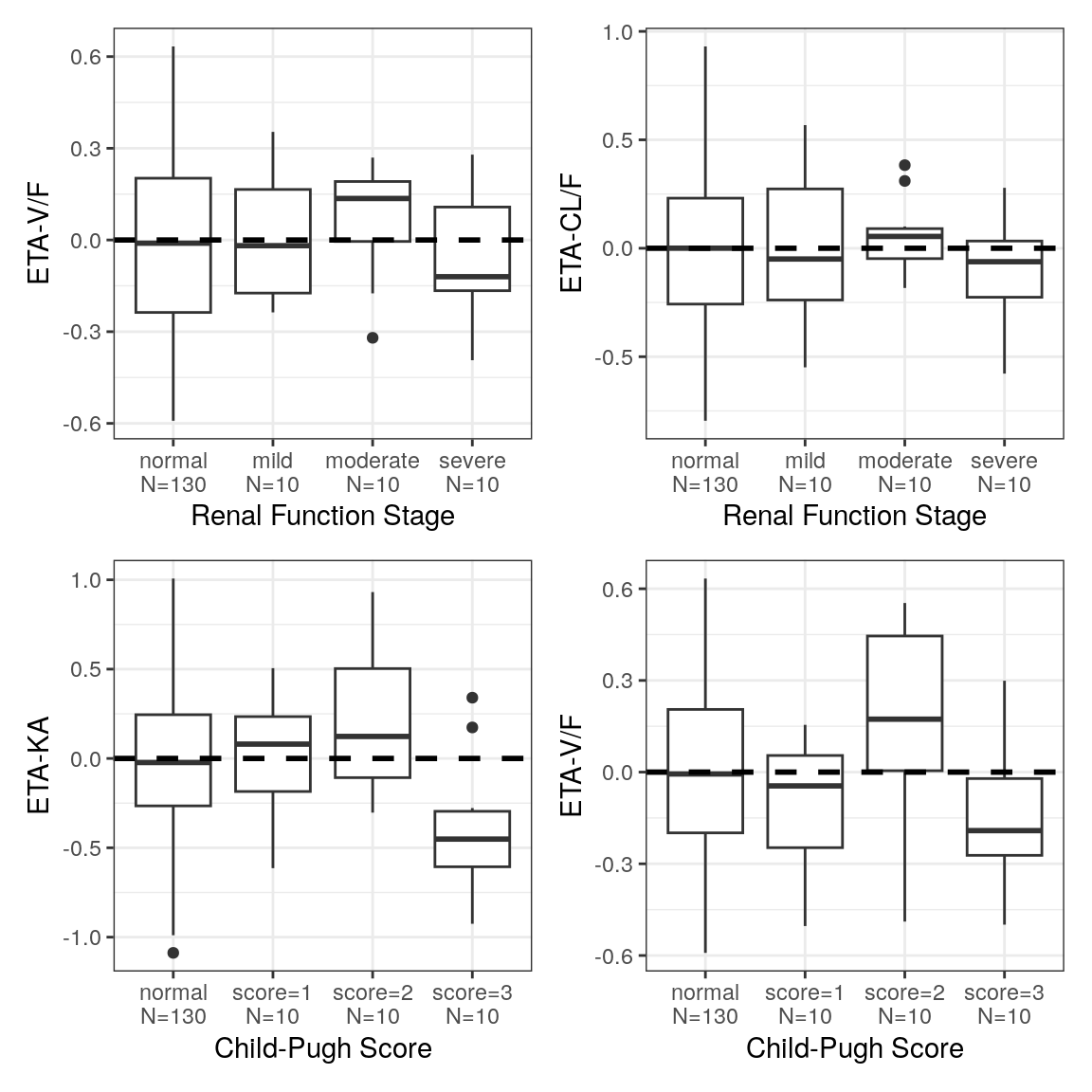
9 Other resources
The script discussed on this page can be found in the Github repository. To run this code you should consider visiting the About the Github Repo page first.
- Runnable version of the examples on this page: model-diagnostics.R.
9.1 Publications
- Nguyen et al. Model Evaluation of Continuous Data Pharmacometric Models: Metrics and Graphics. CPT Pharmacometrics Syst Pharmacol. 2017 Feb;6(2):87-109.
- Byon et al. Establishing best practices and guidance in population modeling: an experience with an internal population pharmacokinetic analysis guidance. CPT Pharmacometrics Syst Pharmacol. 2013 Jul 3;2(7):e51. doi: 10.1038/psp.2013.26. PMID: 23836283; PMCID: PMC6483270.